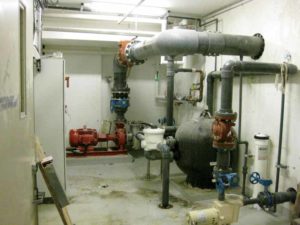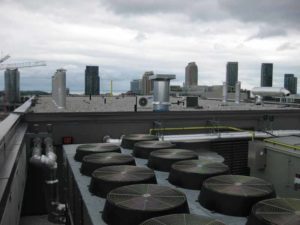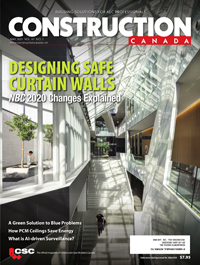The challenge of noise mitigation

Building services
Among the sources listed above, the most significant content is in OBC Article 9.11.2.2, in which the code acknowledges the fact building services in an assembly may have an adverse effect on achieving the required STC rating.
Usually, service penetrations are incorporated into various assemblies and may include, but are not limited to, the following elements:
- ducts;
- metal and/or plastic pipes;
- risers;
- electrical conduits;
- cables;
- light fixtures;
- hangers;
- junction boxes; and
- sprinkler, drain, or vent pipes.
People are typically afflicted with many sounds from building services and equipment that may affect them adversely. These can include noises from pipes, ducts, or drains, toilets flushing, high-pitched sounds, thumps or bangs, slight ticking noises, rattling at registers or grills, whistling air-conditioning, humming sounds at compressors or motors for fans or exhaust, expansion or contraction of water/air supplies, or air movement. While interior partition assemblies are usually selected prescriptively during the design phase (refer to SB-3 of OBC) and from a large number of listed assemblies lab-tested in accordance with ASTM E90, Standard Test Method for Laboratory Measurement of Airborne Sound Transmission Loss of Building Partitions and Elements, their performance in the field rarely, if ever, meets the lab results (assuming the lab tests are performed in a controlled environment with no incorporation of building services or penetrations).
In the field, interior partition assemblies are used as a component of the overall building assembly, which usually includes various penetrations and interferences of building services at a given partition as well as perimeter abutment to other building elements (e.g. window walls, curtain walls, other exterior cladding, or interior acoustically rated assemblies and partitions).

Risk areas
In other words, it is straightforward to maintain the STC rating of a given assembly. However, it is challenging to maintain and control the sound around transition details, construction joints, or deflection gaps where allowances have been designed to permit for structural movement and where expansion and contraction are anticipated.
Through these risk areas, the sound finds its best route to navigate the building from one suite to another and from each area to the adjacent one without any disturbances from noise control. That route may be called a weakness in the design or blind spot, or sometimes an intrusion of sounds. However, it might also be termed the path of least resistance.
A simple example would be sound propagation through the suite entrance door, where sound leaks through perimeter gaps designed as a provision for ventilation, circulation, and pressurization for odour control purposes.
In accordance with OBC, determination of actual performance in the field can be made using parameters and methods detailed in ASTM E336, Standard Test Method for Measurement of Airborne Sound Attenuation Between Rooms in Buildings. Bearing in mind field performance usually falls short of results expected based on prescriptive selections, it would be prudent to aim higher when considering prescriptive methods or paths. Additionally, paying close attention during construction is equally crucial to addressing the weak spots and ensuring the desired performance in the field (including, of course, end user satisfaction).
In most construction projects, unforeseen scenarios and site conditions force contractors, installers, and sometimes designers (if they are informed) to make some changes and modifications to the assembly that were not included in the original design. Those deviations may impact the overall performance and lead to totally unpredicted results.
Acoustical partitions should be tested in the field to ensure compliance with design intent and OBC minimum requirements. Leaving it up to the occupants to determine the practicability and performance of the acoustical wall or assembly means the consultants have not performed their duty, leaving potential gaps and complaints that could lead to litigation involving the building auditor, condo board, developer, acoustical consultant, field review consultant, and others.

Comparison
Most ‘brick-and-mortar’ building construction is relatively straightforward. Live and dead load factors are evaluated and structural components and assemblies are designed to meet the calculated requirements and ensure structural integrity.
However, addressing noise mitigation is not nearly as simple as addressing structural requirements. The effects of noise are very subjective and can be more or less disruptive based on many different considerations (such as those described earlier in this article).
For example, an intermittent noise may be more disruptive than the same noise if it was constant. Some professors of neurology suggest white/pink noise can help patients sleep better. A person’s perception and ability to hear tends to vary with age, so the frequency of a given noise also plays a part. One should also consider whether the noise resonates with something in the affected space. Is one tenant’s music another’s noise?
Is the total absence of sound desirable? Probably not. Some types of noise (e.g. white noise) might be beneficial for certain individuals when trying to sleep, for example. However, there are few things more annoying than undesired noise, and the settled world is teeming with it. In fact, the air we breathe carries and surrounds us with bits of that undesirable noise. Not only does air transfer the noise, but the components of the buildings we create also provide conduits for it to transfer.
Noise seems to be quite adept at switching between these modes of transport. Materials and methods used to reduce airborne sounds are not particularly effective in combating structure-borne sound. Added to the mix is the fact with few exceptions, acoustical performance of buildings has not historically been a primary concern to builders, due to the difficulty and expense of addressing it.
The surrounding community also presents a vast array of noise generators—some constant, but most transitory (e.g. traffic). As well as community noises, a building itself provides additional noise sources, such as air movement, wind tunnel/turbulence, vehicular traffic, mechanical/electrical systems, and occupants.
While the size of the livable space may not have a critical bearing on noise control, the layout, selected material, and assemblies do.







